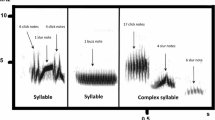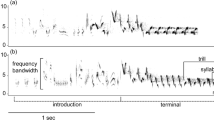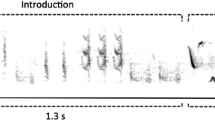Abstract
Male birds sing to find a mate or to defend a territory. Their songs are known to be highly species-specific, but males may additionally show high levels of song individuality. Differences in song features have been shown to code for male quality and/or motivational states. Quantifying differences and similarities in the singing of males may broaden the general understanding of avian song and pairing systems. Here, we investigated the song of an Eastern German population of Reed Buntings (Emberiza schoeniclus), a species with a medium-sized song repertoire and extraordinary high extra-pair young rates (up to 55 %). Using a computed template-recognition algorithm, we analysed songs of 11 males focussing on individual variation in song composition and use. To determine the degree of song sharing among males, we compared two different measurements of song similarity (DICE coefficient and coefficient of compositional similarity; CCS). We found that males sing highly individual with respect to most analysed parameters. On average, males shared 62 % of their syllable type repertoire with at least one other male. However, taking song use into account, the overall degree of song sharing was low to moderate for both similarity measures, and average DICE values were higher than the CCS values. Additionally, we found that the closer the male territories were to each other, the higher the proportion of song sharing tended to be. We discuss the implications of our findings for the function of song in the Reed Bunting.
Zusammenfassung
Das Gleiche, nicht dasselbe: Männliche Rohrammern ( Emberiza schoeniclus ) zeigen große individuelle Unterschiede in der Gesangskomposition, sowie im Teilen und der Nutzung von Silben
Männliche Vögel singen, um eine Partnerin zu finden und/oder ihr Territorium zu verteidigen. Obwohl Vogelgesang stark artspezifisch ist, können Männchen innerhalb einer Art auch sehr individuelle Gesangsmerkmale aufweisen. Unterschiede in den Gesangseigenschaften kodieren dabei für die Qualität eines Männchens oder seinen Motivationszustand. Die Quantifizierung innerartlicher Gesangsvariabilität kann dazu beitragen, das generelle Verständnis für bestimmte Gesangsfunktionen und Paarungssysteme verschiedener Arten zu erweitern. In der vorliegenden Studie untersuchten wir den Gesang einer Population von Rohrammern (Emberiza schoeniclus). Männchen dieser Art besitzen ein Gesangsrepertoire mittlerer Größe. Zudem konnten Untersuchungen eine außergewöhnlich hohe Rate von außerehelich gezeugten Nachkommen (bis zu 55 %) nachweisen. Wir untersuchten die Gesänge von 11 Rohrammermännchen unter Anwendung eines Mustererkennungs-Algorithmus des Soundanalyseprogramms Avisoft. Dabei erfassten wir individuelle Unterschiede in der Repertoire-Komposition sowie den Einsatz einzelner Repertoire-Elemente im Gesang. Um den Anteil der von Männchen geteilten Gesangselemente zu bestimmen, haben wir zwei verschiedene Maße für Gesangsähnlichkeit verglichen (DICE Koeffizient und Koeffizient kompositioneller Ähnlichkeit; CCS). Wir zeigen, dass die Männchen in Bezug auf die meisten gemessenen Gesangsparameter sehr individuell vokalisierten. Im Durchschnitt teilten sie 62 % ihres Silbenrepertoires mit mindestens einem anderen Männchen. Jedoch war, wenn die Verwendung der im Repertoire enthaltenen Silben berücksichtigt wurde, der Gesamtanteil der gemeinsamen Elemente für beide Ähnlichkeitsmaße eher moderat. Die durchschnittlichen DICE-Werte waren dabei geringer als die CCS-Werte. Des Weiteren teilten sich näher beieinander singende Männchen tendenziell größere Teile ihres Repertoires als weiter entfernt voneinander singende Männchen. Wir diskutieren unsere Ergebnisse im Hinblick auf mögliche Gesangsfunktionen bei der Rohrammer.








Similar content being viewed by others
References
Akçay C, Tom ME, Campbell SE, Beecher MD (2013) Song type matching is an honest early threat signal in a hierarchical animal communication system. Proc R Soc Lond B 280:0122517
Beecher MD, Brenowitz EA (2005) Functional aspects of song learning in songbirds. Trends Ecol Evol 20:143–149
Beecher MD, Campbell SE (2005) The role of unshared songs in singing interactions between neighbouring song sparrows. Anim Behav 70:1297–1304
Beecher MD, Stoddard PK, Campbell SE, Horning CL (1996) Repertoire matching between neighbouring song sparrows. Anim Behav 51:917–923
Beecher MD, Campbell SE, Nordby JC (2000) Territory tenure in song sparrows is related to song sharing with neighbours, but not to repertoire size. Anim Behav 59(1):29–37
Bouwman KM, Komdeur J (2006) Weather conditions affect levels of extra-pair paternity in the reed bunting Emberiza schoeniclus. J Avian Biol 37:238–244
Bouwman KM, Van Dijk RE, Wijmenga JJ, Komdeur J (2007) Older male reed buntings are more successful at gaining extrapair fertilizations. Anim Behav 73:15–27
Briefer E, Rybak F, Aubin T (2010) Are unfamiliar neighbours considered to be dear-enemies? PLoS ONE 5:e12428
Brooks RJ, Falls JB (1975) Individual recognition by song in white-throated sparrows, I. Discrimination of songs of neighbors and strangers. Can J Zool 53:879–888
Burt JM, Campbell SE, Beecher MD (2001) Song type matching as threat: a test using interactive playback. Anim Behav 62:1163–1170
Byers BE, Kroodsma DE (2009) Female mate choice and songbird song repertoires. Anim Behav 77:13–22
Catchpole CK, McGregor PK (1985) Sexual selection, song complexity and plumage dimorphism in European buntings of the genus Emberiza. Anim Behav 33:1378–1379
Catchpole CK, Slater PJB (2008) Bird song: biological themes and variations. Cambridge University Press, Cambridge
Dice LR (1945) Measures of the amount of ecologic association between species. Ecology 26:297–302
Dixon A, Ross D, O’Malley SLC, Burke T (1994) Paternal investment inversely related to degree of extra-pair paternity in the reed bunting. Nature 371:698–700
Ehrengruber MU, Pasinelli G, Egli T (2006) Gesangsvariabilität der Rohrammer Emberiza schoeniclus. Schweiz Ornithol Beob 103:87–96
Eriksen A, Slagsvold T, Lampe H (2011) Vocal plasticity: are pied flycatchers, Ficedula hypoleuca, open-ended learners? Ethology 117:188–198
Fisher J (1954) Evolution and bird sociality. In: Huxley J, Hardy AC, Ford EB (eds) Evolution as a process. Allen and Unwin, London
Gailly P (1982) Etude du système de communication du Bruant des roseaux (Emberiza schoeniclus L.): importance des composantes temporelles du chant. Alauda 56:404
Garamszegi LZ, Zsebők S, Török J (2012) The relationship between syllable repertoire similarity and pairing success in a passerine bird species with complex song. J Theor Biol 295:68–76
Gil D, Gahr M (2002) The honesty of bird song: multiple constraints for multiple traits. Trends Ecol Evol 17:133–141
Griffith SC, Owens IPF, Thuman KA (2002) Extra pair paternity in birds: a review of interspecific variation and adaptive function. Mol Ecol 11:2195–2212
Handley HG, Nelson DA (2005) Ecological and phylogenetic effects on song sharing in songbirds. Ethology 111:221–238
Hasselquist D, Bensch S, von Schantz T (1996) Correlation between male song repertoire, extra-pair paternity and offspring survival in the Great Reed Warbler. Nature 381:229–232
Hultsch H, Todt D (1981) Repertoire sharing and song-post distance in nightingales (Luscinia megarhynchos B.). Behav Ecol Sociobiol 8:183–188
Keulen C, Praxaysombath B, Ruwet JC (1999) Vocalisations du bruant des roseaux (Emberiza schoeniclus): evolution des caracteristiques individuelles et regionales du chant (1982–1997). Cah Ethol 19:17–56
Kipper S, Kiefer S (2010) Age-related changes in birds’ singing styles: on fresh tunes and fading voices? Adv Study Behav 41:77–118
Kipper S, Mundry R, Hultsch H, Todt D (2004) Long-term persistence of song performance rules in nightingales (Luscinia megarhynchos): a longitudinal field study on repertoire size and composition. Behaviour 141:371–390
Kipper S, Mundry R, Sommer C, Hultsch H, Todt D (2006) Song repertoire size is correlated with body measures and arrival date in common nightingales, Luscinia megarhynchos. Anim Behav 71:211–217
Kramer HG, Lemon RE, Morris MJ (1985) Song switching and agonistic stimulation in the song sparrow (Melospiza melodia): five tests. Anim Behav 33:135–149
Krebs JR, Ashcroft R, van Orsdol K (1981) Song matching in the great tit Parus major. Anim Behav 29:918–923
Logue DM, Forstmeier W (2008) Constrained performance in a communication network: implications for the function of song-type matching and for the evolution of multiple ornaments. Am Nat 172:34–41
Marthinsen G, Kleven O, Brenna E, Lifjeld JT (2005) Part-time mate guarding affects paternity in male reed buntings (Emberiza schoeniclus). Ethology 111:397–410
Matessi G, Pilastro A, Marin G (2000a) Variation in quantitative properties of song among European populations of reed bunting (Emberiza schoeniclus) with respect to bill morphology. Can J Zool 78:428–437
Matessi G, Dabelsteen T, Pilastro A (2000b) Responses to playback of different subspecies songs in the Reed Bunting Emberiza schoeniclus. J Avian Biol 31:96–101
Mayer C, Pasinelli G (2013) New support for an old hypothesis: density affects extra-pair paternity. Ecol Evol 3:694–705
McGregor, PK and Krebs, JR (1989) Song learning in adult great tits (Parus major): effects of neighbours. Behaviour 139–159
Musilová Z, Musil P, Fuchs R, Poláková S (2011) Territory settlement and site fidelity in Reed Buntings Emberiza schoeniclus. Bird Study 58:68–77
Nemeth E (1994) Individuelles Erkennen des Gesangs durch die Weibchen und Gesangsaktivität der Männchen bei der Rohrammer (Emberiza schoeniclus). J Ornithol 135:217–222
Nemeth E (1996) Different singing styles in mated and unmated reed buntings Emberiza schoeniclus. Ibis 138:172–176
Nicholson JS, Buchanan KL, Marshall RC, Catchpole CK (2007) Song sharing and repertoire size in the sedge warbler, Acrocephalus schoenobaenus: changes within and between years. Anim Behav 74:1585–1592
Nordby JC, Campbell SE, Beecher MD (2007) Selective attrition and individual song repertoire development in song sparrows. Anim Behav 74:1413–1418
Osiejuk TS (2011) The song of the Cinnamon-breasted Bunting, Emberiza tahapisi, in the Bamenda Highlands (NW Cameroon). J Ornithol 152:651–659
Osiejuk TS, Ratynska K, Cygan JP, Dale S (2003) Song structure and repertoire variation in ortolan bunting (Emberiza hortulana L.) from isolated Norwegian population. Ann Zool Fenn 40:3–16
Peake TM, Matessi G, McGregor PK, Dabelsteen T (2005) Song type matching, song type switching and eavesdropping in male great tits. Anim Behav 69:1063–1068
Petruskova T, Osiejuk TS, Petrusek A (2010) Geographical patterns and individual differences of song variation in tree pipit (Anthus trivialis). Auk 127:274–282
Podos J, Warren PS (2007) The evolution of geographic variation in birdsong. Adv Study Behav 37:403–458
Podos J, Peters S, Rudnicky T, Marler P, Nowicki S (1992) The organization of song repertoires in song sparrows: themes and variations. Ethology 90:89–106
R Development Core Team (2009) R: a language and environment for statistical computing. R Foundation for Statistical Computing, Vienna, Austria. ISBN 3-900051-07-0. Available at: http://www.R-project.org
Rutkowska-Guz JM, Osiejuk TS (2004) Song structure and variation in yellowhammers Emberiza citrinella from western Poland. Pol J Ecol 52:333–345
Searcy WA (1992) Song repertoire and mate choice in birds. Am Zool 32:71–80
Searcy WA, Yasukawa K (1990) Use of the song repertoire in intersexual and intrasexual contexts by male Red-winged Blackbirds. Behav Ecol Sociobiol 27:123–128
Skierczynski M, Czarnecka KM, Osiejuk TS (2007) Neighbour-stranger discrimination in territorial ortolan bunting Emberiza hortulana males. J Avian Biol 38:415–420
Sprau P, Mundry R (2010) Song type sharing in common nightingales, Luscinia megarhynchos, and its implications for cultural evolution. Anim Behav 80:427–434
Stoddard PK, Beecher MD, Horning CL, Willis M (1990) Strong neighbor-stranger discrimination in song sparrows. Condor 92:1051–1056
Suter SM, Ermacora D, Rieille N, Meyer DR (2009) A distinct Reed Bunting dawn song and its relation to extrapair paternity. Anim Behav 77:473–480
Todt D, Naguib M (2000) Vocal interactions in birds: the use of song as a model in communication. Adv Study Behav 29:247–296
Tryjanowski P, Osiejuk TS, Kupczyk M (2001) Bunting studies in Europe. Nauk, Poznań
Vehrencamp SL (2001) Is song-type matching a conventional signal of aggressive intentions? Proc R Soc Lond B 268:1637–1642
Węgrzyn E, Leniowski K, Osiejuk TS (2009) Introduce yourself at the beginning—possible identification function of the initial part of the song in the Great Reed Warbler Acrocephalus arundinaceus. Ornis Fenn 86:71–70
Acknowledgments
We are most grateful to Prof. Wolfgang Dohle for kindly introducing us to the Reed Bunting population at the ‘National Park Unteres Odertal’ and acknowledge Michael Weiss for familiarising us with the computer-based template-recognition algorithm in Avisoft. Furthermore, we would like to thank Sarah Kiefer, Kim G. Mortega, Michael Weiss and an anonymous reviewer for valuable discussions throughout the study.
Author information
Authors and Affiliations
Corresponding author
Additional information
Communicated by F. Bairlein.
C. Bartsch and S. L. Voigt-Heucke contributed equally.
Rights and permissions
About this article
Cite this article
Bessert-Nettelbeck, M., Kipper, S., Bartsch, C. et al. Similar, yet different: male Reed Buntings (Emberiza schoeniclus) show high individual differences in song composition, rates of syllable sharing and use. J Ornithol 155, 689–700 (2014). https://doi.org/10.1007/s10336-014-1052-x
Received:
Revised:
Accepted:
Published:
Issue Date:
DOI: https://doi.org/10.1007/s10336-014-1052-x




